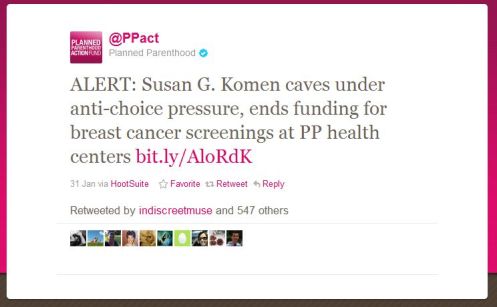Susan G. Komen for the Cure announced Tuesday of last week they would no longer grant money to Planned Parenthood in what appeared to be a purely politically driven move. By Friday, they had reversed course amidst an outpouring of anger. A look at the events that transpired in those roughly 72 hours provides us with a lesson on how social media can change public policy decisions.
Shortly after the initial announcement, Planned Parenthood sprung into action. Having been under attack for many years now, their PR team has lots of experience in dealing with bad publicity – and the calculated response began with a tweet.
Of course, it didn’t end there. Planned Parenthood continued to tweet, retweet, post to Facebook and drive the conversation across multiple platforms. Yahoo! News did a nice job summing up the Twitter activity. Planned Parenthood used what Yahoo! calls ‘influencers’, people with lots of friends and influence, to help drive home the message and expand the scope and reach the original message had.
Beyond the tweets and general message, Planned Parenthood took it a step further in requesting donations. Nothing like a good outrage to get people to open their wallets for a cause they strongly believe in. In less than 24 hours, they had raised $400,000 dollars with even Michael Bloomberg, mayor of New York, pledging to match donations to a certain amount.
Planned Parenthood’s response was also very reader focused. Rather than make the cause about the institution, they made it about the people who use their services. The form that was circulated to request donations was accompanied by a personal story with the tagline, “I stand with Planned Parenthood.” Moving the focus from an organization to the people is a shrewd move. Not only is it harder to scrutinize individual people, but it also gives the argument a more personal feeling.

photo from cnn.com
Where Planned Parenthood did all the right things, Komen for the Cure had several missteps.
While Planned Parenthood was mobilizing and driving the conversation online, Komen was by in large, absent from the conversation. Rather than responding immediately to the criticism, they allowed their Facebook page to be bombarded as well as their own forum was filled with outrage from people who felt the organization had given into political pressure at the demise of women’s health.
The following day, 24 hours later, the organization released a video from their founder and CEO, Nancy Brinker. Rather than show empathy to the 1 in 5 women who have used Planned Parenthood’s services, Brinker chose a more combative stance calling the attacks “hurtful and distracting.” In fact, there was no mention of Planned Parenthood at all, a huge mistake considering the events that had already transpired. Here is the YouTube response that now has thousands more views then all their other posted videos combined.
Planned Parenthood understood that you have to make those personal connections; you have to make the conversation about the user, not the institution. By making it personal, Planned Parenthood won the battle in the public arena.
Komen for the Cure, conversely, didn’t fully understand how to harness this. Not only did they not engage and show empathy, they took a combative stance. Even today, the comments users left on their forum are all taken down regarding the Planned Parenthood decision. They claim they are organizing them and will re-post them shortly, but I would not expect it to be anytime soon.

[…] my Mammagram” showing her disapproval on their decision to defund Planned Parenthood – a decision they had to walk back amid public outcry. The board today has over 1500 followers and exemplifies the potential this […]